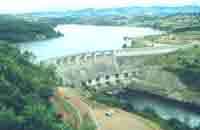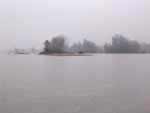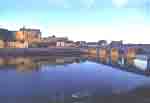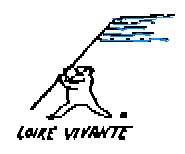the network of citizens and NGOs who is fighting for a living Loire River |
|
Chronology of the Loire Debate over the years (suite)
1990 - January: Demonstrators stop roadworks meant for the construction of the Serre de la Fare dam.
- February 5: Responding to Jean Royer, who had said that construction of Serre de la Fare wouldn't be stopped by "ten nitwits", SOS Loire Vivante, to show its strength, summons up 300 of its members in two hours for a demonstration in Brives-Charensac.
- February 6: Loire Vivante meets Prime Minister Michel Rocard.
- February 7: First government communication concerning the Loire.
The state proposes to the EPALA a chart on the global management of the Loire, which would guarantee population safety against major floods and sufficient water supply, as well as preserve the natural environment. It would be based on the following principles:
* considering its cost and its impact on the environment, the Serre de la Fare dam project will have to undergo further studies. In the meantime, the state will study alternative solutions: dykes and "dry dam" (a "dry dam" only retains water in case of a flood; there is no permanent reservoir);
* the Le Veurdre dam project will be meant only to control exceptional floods;
* Naussac II, which will help fill up the existing Naussac reservoir, will be built;
* the capacity of the Chambonchard reservoir will be reexamined in 1990, considering the study of future needs, notably in terms of farming needs;
* better maintenance of the Loire river bed and publication of a register compiling all the areas liable to flooding;
* a program of protection of the natural environment and other measures will be launched.- June: Publication of the GRRM sociological study on the 1980 flood. It shows the lack of prevention (notably urbanization in areas liable to flooding) and the lack of an adequate flood-alert system, partly due to the local culture, which is aware of the dangers of the Loire but forgets the risk of exceptional floods. The local authorities' 1982 decision to support Serre de la Fare partakes in this attitude and shows their refusal to assume the responsibility to protect the population: with a dam, responsibility is shifted to the state. The issue of the dam has also shifted attention from the improvements which have taken place since 1980 in terms of prevention and flood-alert.
- August 18-September 2: "The Salmon Migration": 25 major obstacles are found on the salmon route upstream the Loire and the Allier rivers. From the estuary up to the Allier spawning grounds, this walk shows how the river and its symbol, the salmon, are hurt by many factors.
- September: Second advertizing campaign launched by SOS Loire Vivante. "A free Loire, a source of life".
- September: The "fourth solution". SOS Loire Vivante publishes a document on the "4th solution". It advocates minor works on the Loire bed to let the flood go past; suppressing some obstacles which worsen the flood by spreading the water, an ecological maintenance of the riverbanks, strict enforcement of the interdiction to build in areas liable to flooding and an improvement of the flood-alert system.
- November 8-16: SOS Loire Vivante organizes a weeklong conference on water in Le Puy. Lectures, meetings, slide-shows...
- November 17: "Live with the river" colloquium in Le Puy. Organized by Loire Vivante et SOS Loire Vivante to go deeper into the causes and consequences of the 1980 flood and to find alternatives to a dam, this colloquium is an occasion to discuss a certain "risk culture", prevention, information of the population. Several important speeches, notably that of M.Mousel, Director of Water, Pollution Prevention and Risks at the Environment Ministry.
- December: SOS Loire Vivante launches a subscription "Let's buy back the Upper Loire Valley", in order to secure strategic plots of land to oppose the dam construction and to begin working on the sustainable development aspect of the 4th solution.
- December 3: Brice Lalonde suggests to local authorities that they hold a referendum about the Serre de la Fare dam project.
- December 1rst-16: Exhibit about the four solutions in Le Puy, with Loire Vivante, SOS Loire Vivante, the EPALA and the Environment ministry. Out of the 1,000 depositions recorded by visitors on the register of grievances, 800 favor the 4th Solution.
- December 12: Initiated by SOS Loire Vivante, the Collectif Haute-Loire Vivante, uniting 23 associations and political parties and 45 000 member-strong, is created.
- December 21: The Environment Ministry publishes a poll favorable to SOS Loire Vivante. A sample of Haute-Loire inhabitants has been polled on their opinions about Serre de la Fare. This poll shows that the 4th solution is favored by a majority of people. SOS Loire Vivante appears as the most trusted lobby dealing with this issue.
- Late December: the mayors refuse to organize the referendum.
1991 - January 23: SOS Loire Vivante meets the "préfet" of Haute-Loire. 10,000 petitions favoring the 4th solution, collected in 2 weeks, are brought to him in a wheelbarrow.
- January 26: the CABLE is created. It is a committee inside the EPALA, made of mayors, town councillors..., local representatives, who oppose the views of the president of the EPALA and who favor those of Loire Vivante.
- February 7: The state-approval ("DUP") is invalidated by the administrative court of Clermont-Ferrand. The EPALA files an appeal with the Council of State ("Conseil d'Etat"), the highest authority in this kind of case.
- March/June: A study is led by the hydrology laboratory SOGREAH and ordered by SOS Loire Vivante, about the different patterns of floods in Brives-Charensac.
- June: SOS Loire Vivante begins to clear and mark out 14 paths in the Upper Loire Valley, to promote "green" tourism.
- June 15: Demonstration of the Collectif Haute-Loire Vivante in Paris. The demonstration rallies 400 people from the Haute-Loire "département". A delegation meets with Prime Minister's advisers.
- June: Negociation session between the state and the EPALA at the Prime Minister's. Meeting on the 4th solution at the Environment Ministry with Loire Vivante et SOS Loire Vivante.
- July 29: Action on the Allier river against the Naussac II project and to ask that the Poutès-Monistrol dam, an obstacle for salmon migration, be demolished: about 30 demonstrators enter the hydro-electric power station of Monistrol d'Allier. This action is part of a week-long series of actions led by SOS Loire Vivante and Robin des Bois on the upper Allier river.
- July 31: Government decision about the Loire, announced by Prime Minister Edith Cresson and Environment Secretary Brice Lalonde.
The government confirms what had been announced on February 90.
* Serre de la Fare is abandoned: the government favors minor hydraulic works on the bed of the Loire and improvement of the information and flood-alert system;
* Chambonchard is cancelled: the government proposes that the existing Rochebut dam be heightened to reach a capacity of 100 Mm3 to fulfill needs for drinkable, industrial and farming water and to insure flood-control;
* Naussac II is confirmed, as a complementary supply for the Naussac reservoir;
* as for Le Veurdre, the EPALA will have to elaborate a pilot study taking into consideration the effects of a better maintenance of the bed of the Allier.
Furthermore, the goverment announces a policy of active maintenance of the river, a program to protect the natural environment, the creation of a Loire Observatory and the protection of areas liable to flooding from further development.- October 5 and 6: Victory Party at the Serre de la Fare dam site. SOS Loire Vivante decides that the occupation of the dam site will continue until the EPALA gives land that has been bought to build Serre de la Fare back to the farmers. Indeed, in spite of the government decision, the EPALA continues buying land meant for the Serre de la Fare dam project.
1992 - During the year, farmers from the Upper Loire Valley, SOS Loire Vivante, a farmers' trade union (La Confédération Paysanne) and the CIVAM (Center for information and popularization of agriculture and the rural world) create a new structure, the "Upper Loire Valley Farmers". They want to develop diversification, rural tourism, better products and local outlets (markets).
- February 20: SOS Loire Vivante buys an old farm on the upper valley of the Loire, Bonnefont with part of the funds raised by the subscription "Let's buy back the Upper Loire Valley". The funds have now reached more than 250,000F.
- April: Loire Vivante, represented by its coordinator, Christine Jean, receives the Goldman Prize for Europe in San Francisco. This prize, amounting to $60 000, is given to environmental organizations with outstanding results.
- August: The "préfet" publishes a new emergency plan for floods in Haute-Loire.
- Fall: Auditions of the different points of view on the Loire by a Parliament commission. The commission comes to Haute-Loire.
- October 13: the Chambonchard project is reopened by the government of Prime Minister Bérégovoy. Environment Minister Ségolène Royal announces that a small 50Mm3 reservoir will be built.
- December: The state launches technical studies concerning the alternative solutions to the Serre de la Fare dam project.
- December 18: The Loire Cabin, on the occupied Serre de la Fare dam, burns down. There is no doubt that the fire has been set voluntarily, but the police investigation will have no results.
- December: Publication of the parliamentary report on the Loire management: it concludes that Serre de la Fare is the only means to fully protect Brives-Charensac from floods. However, all the alternative solutions should be tried before construction is decided: reinforcement of the alert and emergency systems, strict enforcement of the interdiction to build in areas liable to flooding, removal of the plants and houses built in dangerous areas. A small Chambonchard is deemed to be necessary for water supply (the quantity of which should be reevaluated); Naussac II should be built. The commission has reservations about the usefulness of the Le Veurdre dam.It also advocates a better maintenance of the bed and banks of the river, total stop of gravel extractions, a program to avoid eutrophication of the river, a better balance between environment protection and economic development of the port of Nantes on the estuary, and other measures of protection of the natural environment.
back to the RiverNet Homepage
These pages and their contents are © Copyright 1996 of the European Rivers Network.





